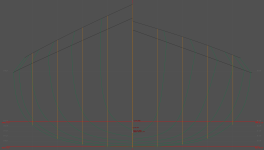That is in Wisconsin.
-
Happy Opening of the Maine Turnpike (1947)! 🛣️🦞🌲
You are using an out of date browser. It may not display this or other websites correctly.
You should upgrade or use an alternative browser.
You should upgrade or use an alternative browser.
Solo daytripper - design ideas
- Thread starter sailsman63
- Start date
The Allagash Wilderness Waterway.. David Yost wanted to sail it on the NFCT and found out that Allagash does not permit that... I don't think he tried to stealth sail.. he was thinking of a removable rig that could be mailed from Chesuncook.
Sailing the Dandy was a great sailing canoe.. It had lots of flare constant.. It was a wide thing to paddle though.
Sailing the Dandy was a great sailing canoe.. It had lots of flare constant.. It was a wide thing to paddle though.
Bit of an update, I took some time today to test-paddle a few canoes at a local Paddle Shop, so now I have new data. Please keep in mind that they are limited to a few more mainstream manufacturers, so if you ask "Why didn't you try xyz?" The answer is probably "They didn't have one."
I had spoken to their Solo Canoe expert on the phone last week to get details about how the test paddles work, and what models to consider. Boats are presented in the order that I paddled them, not the order the shop recommended. Today, the Solo Guy was not in, but the shop owner had some recommendations of his own.
Paddled in a fairly small pond area, not a huge amount of time spent in any of the boats, but with enough space to push up to a short sprint. Paddled kneeling and seated, transitioning between the two out on the water.
Boat 1: Wenonah Argosy, 14'6" x 27" waterline, 30" max, 2.5" rocker.
Shop Owner's 2nd recommendation, Solo Specialist's 3rd
Way too much windage. This canoe is more in the solo tripper category, and with just me aboard tended to skid in the breeze. This was unfortunate, as I was in a protected pond area, in between apartment buildings, on a not very breezy day. I also had a hard time controlling roll. It was not unstable, but I could not get the roll to settle where I wanted it to.
Tracking was meh...
Boat 2: Nova Craft Fox 14, 14' x 32" max, no rocker but very soft stem transition. (New this year, even some of the staff had not had a chance to try it out)
Owner's 1st Recommendation, Solo Specialist's 2nd.
Far too beam-y for my use. Oddly, less initial stability than the narrower Argosy. I did not dare try rolling more than a few degrees, as it felt like it would easily go all the way over. Of the canoes I tried, this was the least flow efficient. An attempt at a sprint sort of self-aborted without going anywhere.
Could not get it to track at all, and directional control was a bit dicey.
Boat 3: Wenonah Vagabond, 14'6" x 29.75", 1.25" rocker (I think that it is very different from the Curtis Vagabond that yellowcanoe mentions above)
Suggested in passing by the staff member who was helping with test paddles, when she saw my reaction to the two above boats.
This one is a flat-bottomed cross section, favored by people who like a stable fishing platform. It tracks a bit better than the above, and does not like being rolled at all. I suspect that this one would actually capsize most easily if you pushed it beyond its roll limits.
Tracking was okay, the boat just felt... dead. The others each had a personality. This canoe had none.
Boat 4: Bell Flashfire, 13' x 25" waterline, 29" max, 2.5" rocker.
Mentioned as an option by Solo Guy on the phone, sort of an afterthought. This was on the shop's used rack, rediscovered in conversation with the test helper.
I've got a bit of a crush on this canoe. Reasonably stable when seated, prefers kneeling or lower seat. Very responsive to paddle, rolls easily, but predictably. With practice, I could see setting a gunwale almost on the water surface.
I actually tried this one out with a double-blade as well as a single blade, and might end up carrying both types of paddle. This was the only canoe that I was able to get into a decent sprint, and it had a surprisingly good glide for such a short hull.
Tracking was not what I thought I was looking for, but the canoe is so responsive to correction and stroke variations that this may not actually be a bother.
What impressed me most was how this hull just seemed to "fit." In the others, I was sort of like awkward cargo. This canoe, I was practically wearing.
The one I didn't paddle: NorthStar Trillium, 14'6" x 25" waterline, 28.5" Max, 2.5" front, 1.5" stern rocker (Asymmetrical)
Owner's 3rd, Solo Guy's 1st
Ran out of time, but this is two shops that have sort of pointed me at the trillium. We would have had to take one off the display floor, but the test helper seemed very surprised that we had not started with this one. I may have to see what I can learn from that.
Upshot: As of this point, my ideal solo would, when paddled flat, track a bit better, and have a little more glide, than the flashfire. Rolling to about 30 deg. should allow it to maneuver about like the flashfire does when flat. Feel free to tell me in what ways I happen to be crazy...
I had spoken to their Solo Canoe expert on the phone last week to get details about how the test paddles work, and what models to consider. Boats are presented in the order that I paddled them, not the order the shop recommended. Today, the Solo Guy was not in, but the shop owner had some recommendations of his own.
Paddled in a fairly small pond area, not a huge amount of time spent in any of the boats, but with enough space to push up to a short sprint. Paddled kneeling and seated, transitioning between the two out on the water.
Boat 1: Wenonah Argosy, 14'6" x 27" waterline, 30" max, 2.5" rocker.
Shop Owner's 2nd recommendation, Solo Specialist's 3rd
Way too much windage. This canoe is more in the solo tripper category, and with just me aboard tended to skid in the breeze. This was unfortunate, as I was in a protected pond area, in between apartment buildings, on a not very breezy day. I also had a hard time controlling roll. It was not unstable, but I could not get the roll to settle where I wanted it to.
Tracking was meh...
Boat 2: Nova Craft Fox 14, 14' x 32" max, no rocker but very soft stem transition. (New this year, even some of the staff had not had a chance to try it out)
Owner's 1st Recommendation, Solo Specialist's 2nd.
Far too beam-y for my use. Oddly, less initial stability than the narrower Argosy. I did not dare try rolling more than a few degrees, as it felt like it would easily go all the way over. Of the canoes I tried, this was the least flow efficient. An attempt at a sprint sort of self-aborted without going anywhere.
Could not get it to track at all, and directional control was a bit dicey.
Boat 3: Wenonah Vagabond, 14'6" x 29.75", 1.25" rocker (I think that it is very different from the Curtis Vagabond that yellowcanoe mentions above)
Suggested in passing by the staff member who was helping with test paddles, when she saw my reaction to the two above boats.
This one is a flat-bottomed cross section, favored by people who like a stable fishing platform. It tracks a bit better than the above, and does not like being rolled at all. I suspect that this one would actually capsize most easily if you pushed it beyond its roll limits.
Tracking was okay, the boat just felt... dead. The others each had a personality. This canoe had none.
Boat 4: Bell Flashfire, 13' x 25" waterline, 29" max, 2.5" rocker.
Mentioned as an option by Solo Guy on the phone, sort of an afterthought. This was on the shop's used rack, rediscovered in conversation with the test helper.
I've got a bit of a crush on this canoe. Reasonably stable when seated, prefers kneeling or lower seat. Very responsive to paddle, rolls easily, but predictably. With practice, I could see setting a gunwale almost on the water surface.
I actually tried this one out with a double-blade as well as a single blade, and might end up carrying both types of paddle. This was the only canoe that I was able to get into a decent sprint, and it had a surprisingly good glide for such a short hull.
Tracking was not what I thought I was looking for, but the canoe is so responsive to correction and stroke variations that this may not actually be a bother.
What impressed me most was how this hull just seemed to "fit." In the others, I was sort of like awkward cargo. This canoe, I was practically wearing.
The one I didn't paddle: NorthStar Trillium, 14'6" x 25" waterline, 28.5" Max, 2.5" front, 1.5" stern rocker (Asymmetrical)
Owner's 3rd, Solo Guy's 1st
Ran out of time, but this is two shops that have sort of pointed me at the trillium. We would have had to take one off the display floor, but the test helper seemed very surprised that we had not started with this one. I may have to see what I can learn from that.
Upshot: As of this point, my ideal solo would, when paddled flat, track a bit better, and have a little more glide, than the flashfire. Rolling to about 30 deg. should allow it to maneuver about like the flashfire does when flat. Feel free to tell me in what ways I happen to be crazy...
Here in lies the problem for the home builder; unless it's a John Winters design finding plans for commercial hulls is difficult. Maybe you can convince someone to lend you a hull, or buy one and sell it afterwards to use as a male plug. Otherwise you're designing it yourself.
Muskrat, I'm pretty sure that I have yet to find a production boat that is exactly what I want anyway....
I did end up going back to try out the Trillium. It was not bad, but I'm reminded of something that yellowcanoe said upthread that I did not really understand at the time. Somehow, It just did not 'fit' right. I realize that the thing I liked best about the Flashfire was that I could lock my knees into both sides of the hull, giving me better control of the roll. Some of the other hulls that I tried made me feel like a package sliding around in the bottom.
Somehow, the Trillium was a bit of a miss. Even though the numbers suggest that it should fit very much like the wildfire, I was not as comfortable. Possibly, this is related to how far the tumblehome extends down the gunwales.
I did end up going back to try out the Trillium. It was not bad, but I'm reminded of something that yellowcanoe said upthread that I did not really understand at the time. Somehow, It just did not 'fit' right. I realize that the thing I liked best about the Flashfire was that I could lock my knees into both sides of the hull, giving me better control of the roll. Some of the other hulls that I tried made me feel like a package sliding around in the bottom.
Somehow, the Trillium was a bit of a miss. Even though the numbers suggest that it should fit very much like the wildfire, I was not as comfortable. Possibly, this is related to how far the tumblehome extends down the gunwales.
G
Guest
Guest
I realize that the thing I liked best about the Flashfire was that I could lock my knees into both sides of the hull, giving me better control of the roll. Some of the other hulls that I tried made me feel like a package sliding around in the bottom.
Feeling “locked” in the hull, especially seated in a two or three point contact stance, is important to a klutz like me. I need all the help (and comfort) I can get.
It is not the prettiest solution, but is easily DIY-able; minicel “knee bumpers” work for me. In the wider soloized tandems, where my comfortable knee spread ends inches short of the inwales, and even in narrower hulls as a cushioned comfy place to press my knees and “lock in” with a foot brace (and back band) while seated.
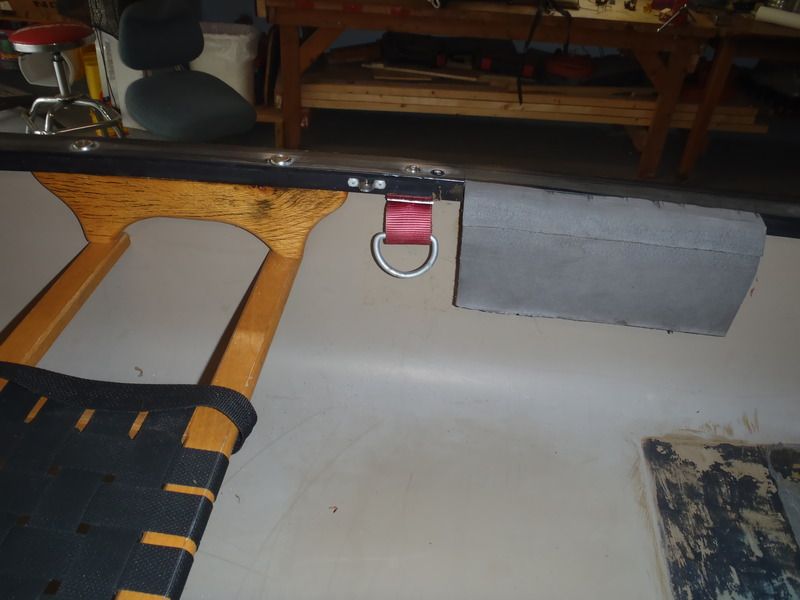
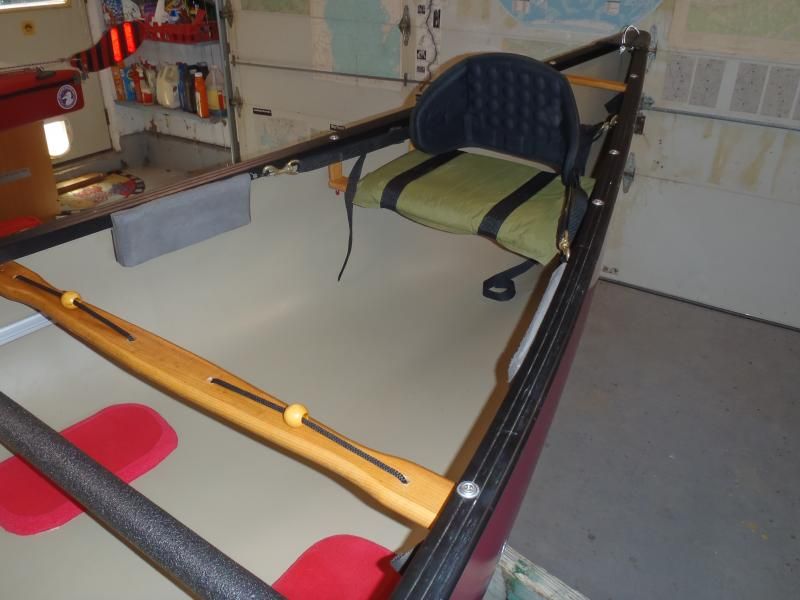
If the rest of the hull shape and design feels right for my paddling peculiarities I can adapt & overcome the knees-locked-on-inwale issue with a couple ounces of minicel weight.
No Title
@Mike Thanks for the photos. I was considering the possibility of adding some stiff padding, though I was specifically talking about the ability to 'lock' while kneeling. I appreciate the practical, make-it-work solutions that you tend to post around here.
Over the last few days, I've sketched up a notional small solo:
Flare-y hull with a knuckle/tumblehome to narrow the paddling station.
Differential rocker, with a flatter stern for tracking while seated for semi-open/flat water paddling. Move the center of mass forward a few inches by going to a kneeling stance, the stern will break free, and I should be able to dance in tight quarters.
Delftship file here, for those who want to play with it.
Right now, the sheer treatment is only blocked in - I'm considering how best to handle the tumblehome. I was pleasantly surprised at how well the sharp knuckle worked out on the last build, however I'm not sure that I want a repeat, especially for glassing the interior of a sharp knuckle.
@Mike Thanks for the photos. I was considering the possibility of adding some stiff padding, though I was specifically talking about the ability to 'lock' while kneeling. I appreciate the practical, make-it-work solutions that you tend to post around here.
Over the last few days, I've sketched up a notional small solo:
Flare-y hull with a knuckle/tumblehome to narrow the paddling station.
Differential rocker, with a flatter stern for tracking while seated for semi-open/flat water paddling. Move the center of mass forward a few inches by going to a kneeling stance, the stern will break free, and I should be able to dance in tight quarters.
Delftship file here, for those who want to play with it.
Right now, the sheer treatment is only blocked in - I'm considering how best to handle the tumblehome. I was pleasantly surprised at how well the sharp knuckle worked out on the last build, however I'm not sure that I want a repeat, especially for glassing the interior of a sharp knuckle.
Attachments
I would think a pedestal seat would be in order. It would take the stress off the knuckle, and if done right, make switching from sitting to kneeling better,
So what do the waterline, length, width dimensions work out to be ?
Jim
So what do the waterline, length, width dimensions work out to be ?
Jim
12' 6.5" DWL
25" beam on WL, 29" at knuckle.
10.5" sheer at midships, as drawn
195# Design displacement.
I might narrow the WL a bit, but that means losing some volume, or stretching the length a bit. A lighter build might help compensate for this a bit. I may also need to add a few more control curves to fine-tune the hull shape - asymetrical curves seem to be touchy with regard to smoothness.
A pedestal seat might bear thinking on, but I like a low CG when seated... probably too low to get my feet under. One thing that I didn't like about the solos that I demoed was the high, slanted seats that came standard on several of them. What I was thinking about is a seat that would swing back out of the way, mounted on cleats in the upper sidewall. More like a wider kneeling thwart than a full seat.
I may also need to put a couple inches of minicell down for a knee lift. My knees take the pressure fine, but if I settle back on my haunches to relax a bit, I get a lot of strain in the balls and arches of my feet. A lift under my knees seems to ease that. Does this sound weird to any of the kneelers out there?
25" beam on WL, 29" at knuckle.
10.5" sheer at midships, as drawn
195# Design displacement.
I might narrow the WL a bit, but that means losing some volume, or stretching the length a bit. A lighter build might help compensate for this a bit. I may also need to add a few more control curves to fine-tune the hull shape - asymetrical curves seem to be touchy with regard to smoothness.
A pedestal seat might bear thinking on, but I like a low CG when seated... probably too low to get my feet under. One thing that I didn't like about the solos that I demoed was the high, slanted seats that came standard on several of them. What I was thinking about is a seat that would swing back out of the way, mounted on cleats in the upper sidewall. More like a wider kneeling thwart than a full seat.
I may also need to put a couple inches of minicell down for a knee lift. My knees take the pressure fine, but if I settle back on my haunches to relax a bit, I get a lot of strain in the balls and arches of my feet. A lift under my knees seems to ease that. Does this sound weird to any of the kneelers out there?
Yup in a solo the best fit is when you can lock your knees into the sides.. That's the number one fit test. Not weight. It seems counterproductive.
Oh foot cramps.. Yes some positions feel unhappy to my feet and they lock up and give me pain.. High seats are more comfortable for me but I'm not paddling your boat. You are. You have to just realize that seat twiddling is possible to make the seat comfy for you..
That you can kneel on your haunches is a sign of youth.. Take it while you can!
Oh foot cramps.. Yes some positions feel unhappy to my feet and they lock up and give me pain.. High seats are more comfortable for me but I'm not paddling your boat. You are. You have to just realize that seat twiddling is possible to make the seat comfy for you..
That you can kneel on your haunches is a sign of youth.. Take it while you can!
For my next seat I am really looking hard at what wysedav did with his Northwest Solo ... I think it would be hard to beat for weight. simplicity and flexibility ... and if it was planned from the construction phase a light reinforcement in that area could be placed
.... just a thought on the seat
Brian
.... just a thought on the seat
Brian
I know we all have our favorite way of building and outfitting things and we all think our way is the best but the rest of you are all wrong because when it comes to seats my way is really the best. For switching between sitting and kneeling it can't be beat. I've spent countless hours thinking about seats that will adjust height and position for sitting vs. kneeling and I've yet to come up with anything easier, lighter, or more functional than a narrow pedestal. Simple to build from shop scraps and you can mount any type of seat on it that you like. My preference is a small bucket but you could use a large bucket or easily adapt a more traditional wood seat to work with it.
If, like me, you normally sit and occasionally kneel then put the seat low for sitting stability. If you normally kneel and sometimes sit then make it a tall seat. The beauty, especially for us sitters, is that you get a comfortably low and stable seat that you can easily kneel around. No trying to squeeze your feet under that seat and no entrapment worries. It only takes a couple seconds to switch positions on the water with no gymnastics required. I've paddled a Wildfire set up for kneeling and even with that tall seat I struggle to get my size 11+ feet under and out from under the seat, especially on the water. With the pedestal I can quickly drop to my knees for just a few seconds to reach my forward pack or to have better stability when pulling off a shirt or jacket and just as quickly go back to sitting. I especially like the ability to quickly and smoothly drop to my knees when I suddenly find the water is getting too rough on an open water crossing. I don't like the thought of giving up boat control in that situation while I try to finagle my feet under the seat.
The seat frame I just installed in my solo 14 is made of cedar and weighs 12oz. plus a couple ounces for the aluminum slides (1" tubing). The entire assembly with seat usually comes in at 2 pounds and gives about 12" of front to rear adjustment. For this boat I shortened the rails so I'll only have 6" of adjustment to save on space, weight, and material.
 20160222_002 by Alan, on Flickr
20160222_002 by Alan, on Flickr
Alan
If, like me, you normally sit and occasionally kneel then put the seat low for sitting stability. If you normally kneel and sometimes sit then make it a tall seat. The beauty, especially for us sitters, is that you get a comfortably low and stable seat that you can easily kneel around. No trying to squeeze your feet under that seat and no entrapment worries. It only takes a couple seconds to switch positions on the water with no gymnastics required. I've paddled a Wildfire set up for kneeling and even with that tall seat I struggle to get my size 11+ feet under and out from under the seat, especially on the water. With the pedestal I can quickly drop to my knees for just a few seconds to reach my forward pack or to have better stability when pulling off a shirt or jacket and just as quickly go back to sitting. I especially like the ability to quickly and smoothly drop to my knees when I suddenly find the water is getting too rough on an open water crossing. I don't like the thought of giving up boat control in that situation while I try to finagle my feet under the seat.
The seat frame I just installed in my solo 14 is made of cedar and weighs 12oz. plus a couple ounces for the aluminum slides (1" tubing). The entire assembly with seat usually comes in at 2 pounds and gives about 12" of front to rear adjustment. For this boat I shortened the rails so I'll only have 6" of adjustment to save on space, weight, and material.
 20160222_002 by Alan, on Flickr
20160222_002 by Alan, on FlickrAlan
@Mike Thanks for the photos. I was considering the possibility of adding some stiff padding, though I was specifically talking about the ability to 'lock' while kneeling. I appreciate the practical, make-it-work solutions that you tend to post around here.
Over the last few days, I've sketched up a notional small solo:
Flare-y hull with a knuckle/tumblehome to narrow the paddling station.
Differential rocker, with a flatter stern for tracking while seated for semi-open/flat water paddling. Move the center of mass forward a few inches by going to a kneeling stance, the stern will break free, and I should be able to dance in tight quarters.
Delftship file here, for those who want to play with it.
Right now, the sheer treatment is only blocked in - I'm considering how best to handle the tumblehome.
That looks like a nice hull so far. I'll be interested to see what the final design looks like. We seem to be after similar boats right now as I'm building something pretty similar at the moment. When I get a chance I'll fire up my PC and post the lines from it.
I was pleasantly surprised at how well the sharp knuckle worked out on the last build, however I'm not sure that I want a repeat, especially for glassing the interior of a sharp knuckle.
I've never found that inside crease to be much of an issue. Looking back at my work I see it must have given me some trouble on my first build (Kite) as there were some small voids there. Problem was I didn't put a thick enough fillet in the corner to help the fiberglass make the turn. I've since been more diligent about the fillet and it hasn't be a problem.
Alan
Alan and I have different versions of pedestal mounted seats...All the advantages that he mentions are worth building into your boat, but wait, there's more!!
What do I consider to be the biggest benefit of a bottom mounted seat?
The freedom of fore-aft movement around the seat.
Without seat rails in the way, it's sooo much easier to move around in the hull. Especially beneficial for me since I stopped dancing professionally.
 I'm just not as flexible as I once was.
I'm just not as flexible as I once was.
For loading, launching and landing, it's very convenient to be able to easily scamper around in the hull. And for those of you that do beaver dams, it's just too easy to unload the bow, traverse the dam, then scoot forward to unload the stern as you exit the dam.
What do I consider to be the biggest benefit of a bottom mounted seat?
The freedom of fore-aft movement around the seat.
Without seat rails in the way, it's sooo much easier to move around in the hull. Especially beneficial for me since I stopped dancing professionally.
For loading, launching and landing, it's very convenient to be able to easily scamper around in the hull. And for those of you that do beaver dams, it's just too easy to unload the bow, traverse the dam, then scoot forward to unload the stern as you exit the dam.
Nah on Alan's seat. It is pretty . It is well made.. It doesn't allow for enough vertical for kneeling for oldsters who have trouble going from kneel to sit without using all the available space under the seat( which there isn't any) . And I couldn't slide all the way over to have both knees in one bilge which I do on twisty creeks..
Now Alan if it had a ratcheting mechanism for up and down. down low for sit and up high for kneel...
Now Alan if it had a ratcheting mechanism for up and down. down low for sit and up high for kneel...
It doesn't allow for enough vertical for kneeling for oldsters who have trouble going from kneel to sit without using all the available space under the seat( which there isn't any) . And I couldn't slide all the way over to have both knees in one bilge which I do on twisty creeks..
Now Alan if it had a ratcheting mechanism for up and down. down low for sit and up high for kneel...
It would be easy to build one with a higher seat but I've yet to think of a good way to make a height adjustable seat. For shimmying over to put both knees in one bilge you'll need a base design more like Stripperguy's.
Alan
This is what I came up with for my design. 14' overall with a 13.1' waterline. 30" max width. 225 pound design load. Symmetrical except for more sheer in the bow (19/13/17).
 solo14 linesplan by Alan, on Flickr
solo14 linesplan by Alan, on Flickr
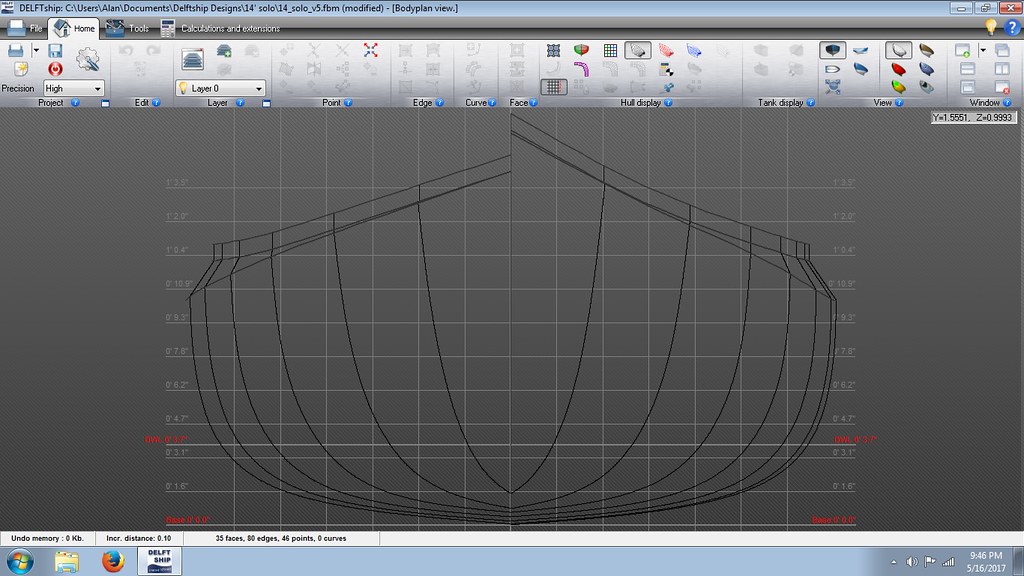 solo14 lines by Alan, on Flickr
solo14 lines by Alan, on Flickr
Alan
 solo14 linesplan by Alan, on Flickr
solo14 linesplan by Alan, on Flickr solo14 lines by Alan, on Flickr
solo14 lines by Alan, on FlickrAlan
Alan, I hear you regarding the tall seat on the wildfire. The flashfire that I demoed was the same, and I've only got size 8! I've always thought that your pedestal seats were very neat and crisply done. I suspect that you could produce and sell them if you wished.
I do have a couple of questions regarding them:
@Cruiser: I did like @wysedave's brackets. If I don't use them for seat mounts, I have a couple of other things in mind.
@yellowcanoe: I get where you are coming from. This hull is narrow enough that I don't know if I would ever want to kneel all the way over to one side. If Alan or someone were to attempt a height-adjustable pedestal, would the height need to be independent of the slide, or would a forward-low/back-high set of positions work for you?
I do have a couple of questions regarding them:
- Do you do anything to allow the slide to lock? That was something that I could not tell in the Bloodvein build. (Just reviewed)
- How do you handle heeling from the seated position? I sometimes shift my weight over to one side of the canoe when paddling my tandem, and I'm not sure how well that would go on the pedestal you show. Even if you mount a wider, more traditional seat, the torque load seems like it could pull the hull mountings. I could see building it wider, but then you lose the kneel-around.
@Cruiser: I did like @wysedave's brackets. If I don't use them for seat mounts, I have a couple of other things in mind.
@yellowcanoe: I get where you are coming from. This hull is narrow enough that I don't know if I would ever want to kneel all the way over to one side. If Alan or someone were to attempt a height-adjustable pedestal, would the height need to be independent of the slide, or would a forward-low/back-high set of positions work for you?
Just an observation !
I see the idea of sitting on the bottom, hasn't surfaced in this discussion.
Truly a sit on the bottom, like a Wee Lasse, would be a great tried and proven option. No need to kneel, as your center of gravity is already low. Also, no need to heel such a short narrow hull such as you have designed.
A pivoting back rest could serve the need if you really wanted to kneel.
This is a fun way to paddle creeks !
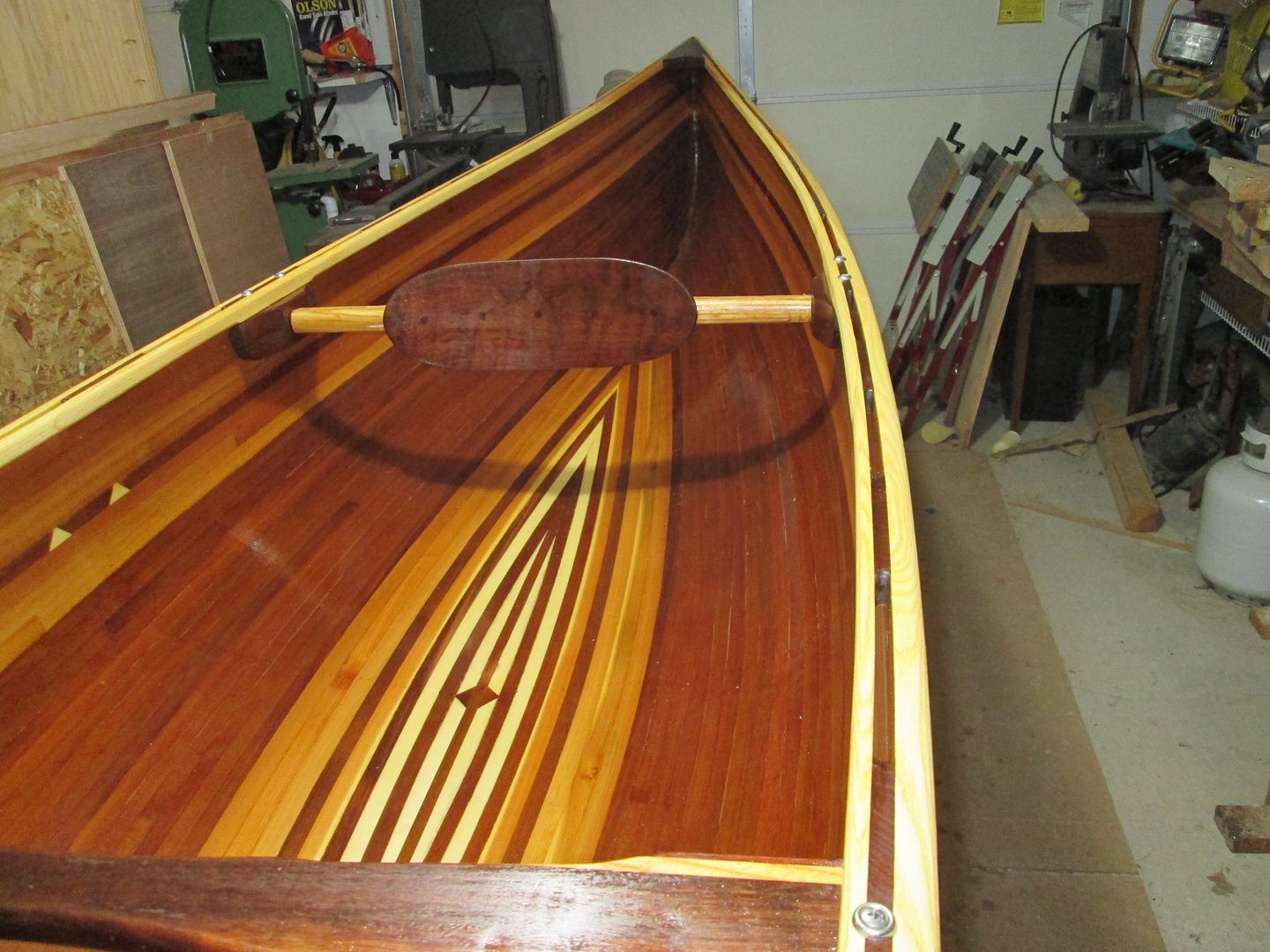
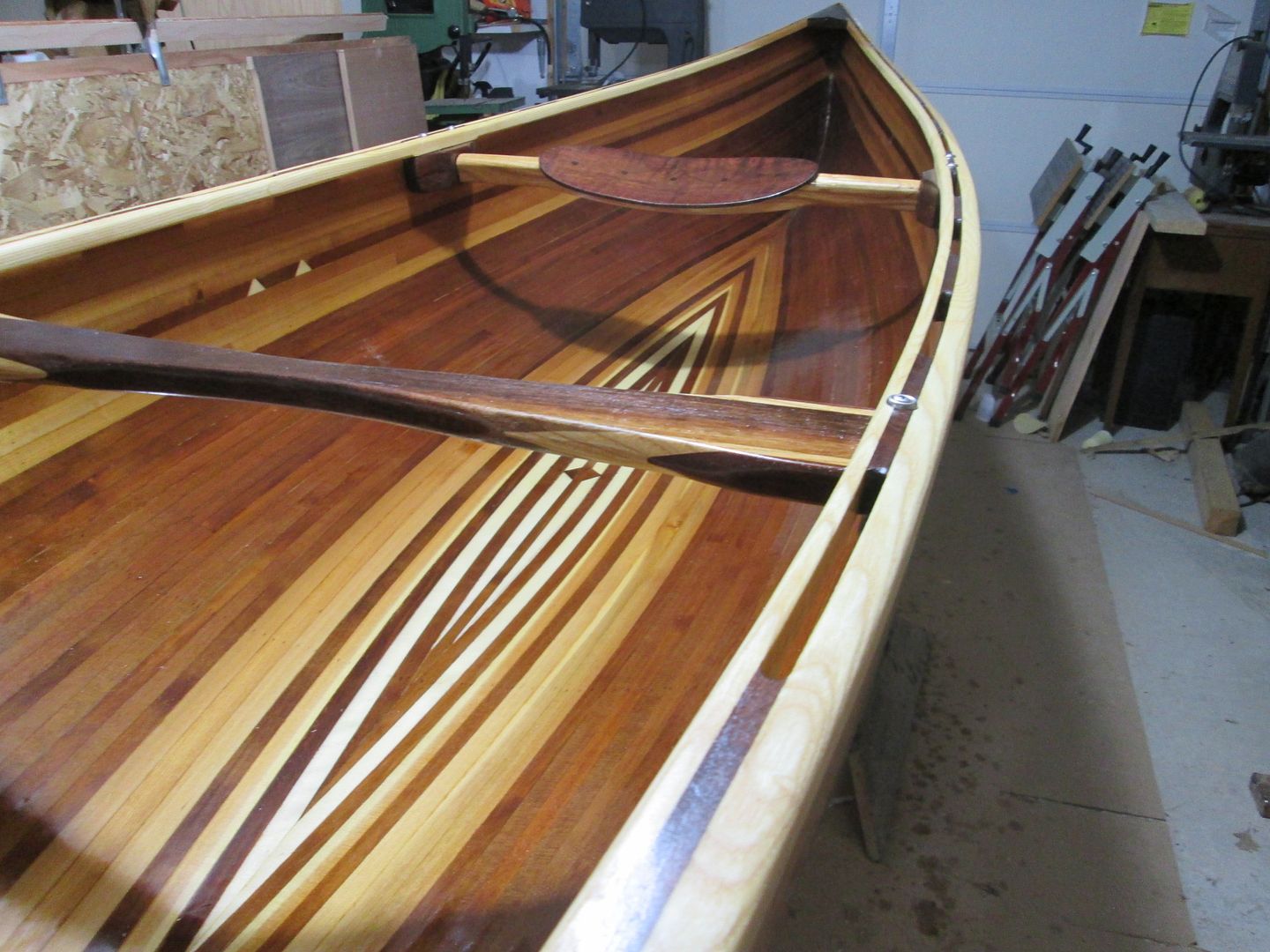
PS. Alan does have a simple and effective locking system on his pedestal seats.
Jim
I see the idea of sitting on the bottom, hasn't surfaced in this discussion.
Truly a sit on the bottom, like a Wee Lasse, would be a great tried and proven option. No need to kneel, as your center of gravity is already low. Also, no need to heel such a short narrow hull such as you have designed.
A pivoting back rest could serve the need if you really wanted to kneel.
This is a fun way to paddle creeks !


PS. Alan does have a simple and effective locking system on his pedestal seats.
Jim
Last edited:
I do have a couple of questions regarding them:
Do you do anything to allow the slide to lock?
Yes. I weld a washer into the slotted head of a hose clamp and slip it over one of the tubes. Quick and easy to find and adjust by feel.
How do you handle heeling from the seated position? I sometimes shift my weight over to one side of the canoe when paddling my tandem, and I'm not sure how well that would go on the pedestal you show. Even if you mount a wider, more traditional seat, the torque load seems like it could pull the hull mountings. I could see building it wider, but then you lose the kneel-around.
I've never felt much need to heel my solo canoes from a sitting position for more than brief periods as most of them are 30" or narrower. Shifting weight from one cheek to the other seems to do the trick there. The bucket seat doesn't allow you to slide over but a more traditional flat seat would and I wouldn't be concerned about it pulling the seat mounts loose. They're held in place with thickened epoxy under the feet and then a couple layers of fiberglass from the hull to seat at each corner.
In my new solo (Barrens) at 32" I do find myself unconsciously heeling the boat a little to help with reach.
Alan
Similar threads
- Replies
- 20
- Views
- 1K
- Replies
- 67
- Views
- 3K
- Replies
- 14
- Views
- 851
- Replies
- 25
- Views
- 4K

